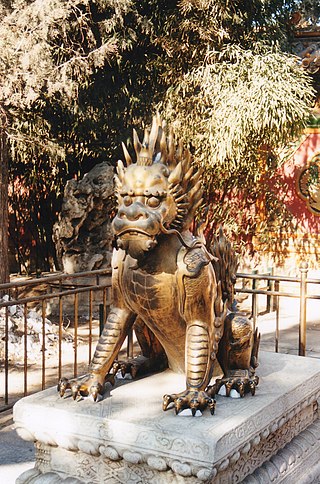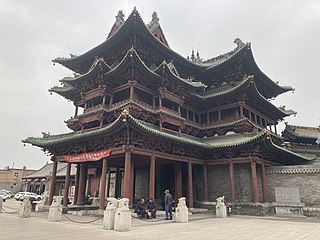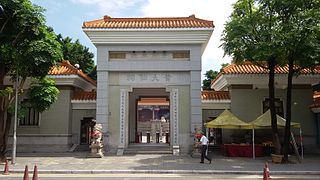
Guangzhou, also known as Canton, is the capital and largest city of Guangdong province in southern China. Located on the Pearl River about 120 km (75 mi) north-northwest of Hong Kong and 145 km (90 mi) north of Macau, Guangzhou has a history of over 2,200 years and was a major terminus of the maritime Silk Road; it continues to serve as a major port and transportation hub as well as being one of China's three largest cities. For a long time, the only Chinese port accessible to most foreign traders, Guangzhou was captured by the British during the First Opium War. No longer enjoying a monopoly after the war, it lost trade to other ports such as Hong Kong and Shanghai, but continued to serve as a major transshipment port. Due to a high urban population and large volumes of port traffic, Guangzhou is classified as a Large-Port Megacity, the largest type of port-city in the world. Due to worldwide travel restrictions at the beginning of the COVID-19 pandemic, Guangzhou Baiyun International Airport, the major airport of Guangzhou, briefly became the world's busiest airport by passenger traffic in 2020.

The Eight Immortals are a group of legendary xian ("immortals") in Chinese mythology. Each immortal's power can be transferred to a vessel (法器) that can bestow life or destroy evil. Together, these eight vessels are called the "Covert Eight Immortals" (暗八仙). Most of them are said to have been born in the Tang or Song Dynasty. They are revered by the Taoists and are also a popular element in secular Chinese culture. They are said to live on a group of five islands in the Bohai Sea, which includes Mount Penglai.

Lü Dongbin is a legendary Chinese scholar and poet said to have lived during the Tang dynasty. His lifetime supposedly spanned two hundred and twenty years. Elevated to the status of an immortal in the Chinese cultural sphere by Daoists, he is one of the most widely known of the group of deities known as the Eight Immortals. Lü is also a historical figure and mentioned in the official history book History of Song. He is widely considered to be one of the earliest masters of neidan, or internal alchemy. He is also depicted in art dressed as a scholar carrying a sword to dispel evil spirits.

The Goat is the eighth of the 12-year cycle of animals which appear in the Chinese zodiac related to the Chinese calendar. This zodiacal sign is often referred to as the "Ram" or "Sheep" sign, since the Chinese word yáng is more accurately translated as Caprinae, a taxonomic subfamily that includes both goats and sheep, but contrasts with other animal subfamily types such as Bovinae, Antilopinae, and other taxonomic considerations which may be encountered in the case of the larger family of Bovidae in Chinese mythology, which also includes the Ox (zodiac). The Year of the Goat is associated with the 8th Earthly Branch symbol, 未 (wèi).

Wong Tai Sin Temple is a well known shrine and tourist attraction in Hong Kong. It is dedicated to Wong Tai Sin, or the Great Immortal Wong. The 18,000 m2 (190,000 sq ft) Taoist temple is famed for the many prayers answered: "What you request is what you get" (有求必應) via a practice called kau chim. The temple is located on the southern side of Lion Rock in the north of Kowloon.

Mount Lao, or Laoshan, is a mountain located near the East China Sea on the southeastern coastline of the Shandong Peninsula in China. The mountain is culturally significant due to its long affiliation with Taoism and is often regarded as one of the "cradles of Taoism". It is the highest coastal mountain in China and the second highest mountain in Shandong, with the highest peak (Jufeng) reaching 1,132.7 metres (3,716 ft). The mountain lies about 30 kilometres (19 mi) to the northeast of the downtown area of the City of Qingdao and is protected by the Qingdao Laoshan National Park that covers an area of 446 square kilometers.

While there are many historical and modern schools of Taoism with different teachings on the subject, many Taoist priests regard their diet as extremely important to their physical, mental and spiritual health in one way or another, especially where the amount of qi in the food is concerned.

The xiezhi is a mythical ancient creature of Chinese origin impact to throughout East Asian legends. It resembles an ox or goat, with thick dark fur covering its body, bright eyes, and a single long horn on its forehead. It has great intellect and understands human speech. The xiezhi possesses the innate ability to distinguish right from wrong, and when it finds corrupt officials, it will ram them with its horn and devour them. It is known as a symbol of justice.
The Tune of Li Zhongtang is the first semi-official national song of China, written by Li Hongzhang in 1896 during the Qing dynasty. It also served as the imperial anthem for the dynasty.

Xichang Station, formerly Dongfeng Road West Station (东风西路站) during planning, is a station on Line 5 of the Guangzhou Metro. It is located under the junction of Huanshi Road West (环市西路) and Dongfeng Road West (东风西路) in the Liwan District of Guangzhou. Huanshi Road West is the main shopping area for shoes in the city. The station opened on 28 December 2009.

Wuyangcun Station, formerly Wuyang New Town Station (五羊新城站) during planning, is a station on Line 5 of the Guangzhou Metro. It is located under the junction of Siyou New Road (寺右新马路) and Guangzhou Avenue (广州大道), in Wuyang New Town, Yuexiu District. It opened on 28 December 2009.

Jiexiu is a county-level city in the central part of Shanxi Province, China. It is under the administration of the prefecture-level city of Jinzhong and is located in the latter's western confines. Notable sites in and around Jiexiu include Mount Mian, Zhangbi Fortress, Houtu Temple and Xianshenlou.
The Eight Views of Ram City, also known as the Eight Sights of Guangzhou is the collective name for various collections of the eight most famous tourist attractions in Guangzhou, China, during different periods of its history. Collections of "Eight Views" is a common trope in Chinese travel literature.
The Temple of the Five Immortals or Five Immortals Temple is a Taoist temple located in Shiyan's Zhangwan District in China's Hubei Province. The temple is situated on the Heavenly Horse peak of White Horse Mountain in the Wudang Mountains. The Wudang Mountains are home to a complex of Taoist temples and monasteries and are associated with the Lord of the North, Xuantian Shangdi. The Temple of the Five Immortals is one of the very few temples in the Wudang mountain range which is still maintained by Taoist monks who dedicate their lives to cultivating the great Tao.

Chinese traditional religion is polytheistic; many deities are worshipped in a pantheistic view where divinity is inherent in the world. The gods are energies or principles revealing, imitating, and propagating the way of heaven, which is the supreme godhead manifesting in the northern culmen of the starry vault of the skies and its order. Many gods are ancestors or men who became deities for their heavenly achievements. Most gods are also identified with stars and constellations. Ancestors are regarded as the equivalent of Heaven within human society, and therefore, as the means of connecting back to Heaven, which is the "utmost ancestral father".

The Legend of Five Goats comes from the ancient Guangzhou city, and is an origin of Guangzhou's nicknames like 'City of Five Goats', 'City of the Goat', 'City of the Rice'. It is also the origin of many Guangzhou local brands' names. The name 'Five Goats' can earliest be seen in poetry of Tang dynasty, and the related legendry can be dated back to Jin dynasty. Though the legendary had several versions, it was unified after Ming dynasty. Usually the Legend of Five Goats reflects the history that Lingnan people was colonized by Zhongyuan ancestors. In 2007, this legend was collected into the first batch of The Masterpieces of the Oral and Intangible Heritage of Humanity of Guangzhou.

The Dafo Temple is a Buddhist temple in Guangzhou, Guangdong, China. Located in Yuexiu District, Dafo Temple is a grand temple with a history of more than one thousand years and was built by Emperor Liu Yan in the Southern Han dynasty (917–971). It has been praised as one of the "Five Largest Temples of Guangzhou" in history. Later it was destroyed and rebuilt many times. In the late Ming dynasty, the temple was declining day by day and was devastated by the war while Shang Kexi and Geng Jimao conquered Guangdong in 1649. During the reign of the Kangxi Emperor in 1663, the temple was rebuilt and expanded by Shang Kexi continuously. According to the national policy of free religious belief, the temple was approved by the Guangzhou Municipal People's Government to be restored as a Buddhist temple in 1981. Then Master Guangming, vice-president of the Guangzhou Buddhist Association, served as abbot; he tried to revitalize Dafo Temple and restore the style of the large temple. On August 9, 1993, Dafo Temple was put on the list as a Municipality Protected Historic Site by the Guangzhou Municipal People's Government.

Lishan Laomu is the goddess of Mount Li in Chinese religion. She is a popular female immortal in the Taoist pantheon, and a high-ranking one according to some late sources. Her origins are said to derive from Nüwa, the legendary creator and mother goddess.

Bixia Yuanjun, also known as Taishan Niangniang, is the goddess of Mount Tai, childbirth and destiny in Chinese traditional religion (Taoism).



















